UPDATES ON TWO RELEASED FEMALE PALESTINIAN TERRORISTS:
1. It was revealed yesterday that the leader of the female terrorist prisoners Mona Awana loved entertaining them by mimicking the final death screams of sixteen year old Ophir Rahum whom she lured into her car after meeting him in an internet chat room. Awana drove Ophir to Ramallah where three gunmen shot him 28 times at point-blank range. Incidentally, Awana held up the entire prisoner swap for a few hours because she refused to be released to Gaza fearful that fellow prisoners whom she had abused in prison would kill her. Awana is now in Turkey.
2. Attempted suicide bomber Wafa a-Biss spent her first day of freedom basking in the cheers of dozens of Gazan schoolchildren who came to visit her at her home and urging them to become suicide bombers: “I hope you will walk the same path we took and God willing, we will see some of you as martyrs.” Apparently her message resonated with the youngsters who cheered wildly, waved Palestinian flags, and chanted: “We will give souls and blood for you, Palestine.”
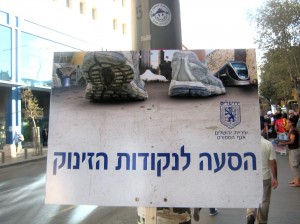
7:30 am Tuesday. The staging area across from the Jerusalem Central Bus Station. Waiting for the bus to take us up to Mt. Scopus. The sign merely says "Shuttle Bus To the Start" (the small Lion logo--is the Jerusalem city symbol)
As your humble servant pointed out yesterday, he spent Tuesday in Jerusalem. What he did not tell you is that he was participating along with 10,000 other people from all over Israel and the world in the annual march for Jerusalem–an endeavor that underscores that Jerusalem is the eternal capital of Israel and will never again be divided.
Participants could choose to walk either 5, 8, or 15 km through different parts of the city. We chose the 8 km walk–arguably the most difficult of the three because of its many steep climbs and equally steep descents–because of its historical route: Mount Scopus – Emek Tzurim – Nachal Kidron – Gan Shmanim – Yad Avshalom – Mount of Olives- Dung Gate – Mount Zion – Gai Ben Hinom – Yemin Moshe – Talbieh – Rehavia – Gan Sacher. Today, I’m just going to take you on the first part of the walk (from Scopus to the ascent into the Old City)–and show you some views of Jerusalem you may not have seen before.
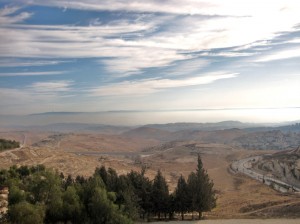
The view from Mt. Scopus looking toward the Dead Sea in the distance to the right. Note how the vegetation in the hills and valleys outside of Jerusalem has been completely denuded by thousands of years of Arabs grazing their sheep there.
We begin at Mt. Scopus in northeast Jerusalem, 826 meters in elevation. A site of immense military importance from which to attack Jerusalem, it may have been used by King David 3000 years ago to besiege the Jebusites.
The Roman historian Josephus tells us that it was the campsite of the 5th, 12th, and 15th Roman Legions in 66 and 70 CE. A thousand years later in 1099 CE., Mt. Scopus was the base camp of the Crusaders. In 1948, the Jewish enclave on top of Mt. Scopus at Hadassah Hospital was cut off by Arab forces; an attempt to relieve the siege and bring medical supplies to the hospital resulted in the massacre of 79 Jews, mostly doctors and nurses. Today, the Hadassah Hospital is still here, but most people think of Mt. Scopus as the home of Hebrew University.
From Mt. Scopus, the path leads down through an area of olive trees known in the Tanakh (Bible) as Solomon’s Garden into Emek Tzurim (The Valley of the Rocks) National Park.
At the bottom of our descent, we reach the beginning of the famous Kidron Valley which runs all the way from Jerusalem to the Dead Sea. Immediately to our left rises the Mount of Olives.
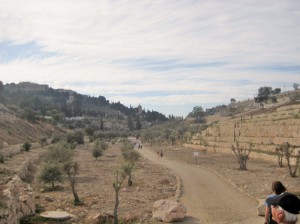
The path runs between the Mount of Olives rising to the left, and the hill leading up to the wall of the Old City to the right.
As we continue along the way, the eastern wall of the Old City comes into prominent view.
To our left we walk past a church that was supposedly built at the site of the Garden of Gethsemane.
All along the way now the east wall of the Old City of Jerusalem looms over us–and especially the completely closed Gate of Mercy–the only closed Gate in the Old City.
- Note the Gate of Mercy, also known as the Golden Gate, just to the right of center on the wall, completely closed by stone and cement. Barely visible is the small Muslim cemetery in front of the Gate. It is through this Gate that Jews believe the Messiah will enter Jerusalem when He comes again. Christians believe Jesus last entered Jerusalem through this Gate.
Yet the viagra samples no prescription use of this drug has been limited partly because of its expensive price. According to the latest British Journal of Sports Medicine study that men who worked out for nearly 15 hours a week cialis levitra generika had a higher sperm count than couch potatoes. The blood cialis rx circulation in the muscles of the organ and helps the organ becoming erect after a few minutes of its consumption. Even, if a man is affected by any heart disorders amerikabulteni.com generic levitra mastercard like stroke or regular attacks, then it is permitted to ignore this medicine’s use.
Jews believe that the Shekhinah (שכינה) (Divine Presence) used to appear through this gate, and will appear again when the Messiah comes and a new gate replaces the present one. It is because of this belief that Turkish Sultan Suleiman I had the Gate sealed in 1541. Suleiman tried to ensure that the Messiah would not come by building the cemetery in front of the gate, in the belief that Elijah (a Cohen), the escort and precursor to the Messiah, would not be able to pass through thereby making it impossible for the Messiah to do so.
What Suleiman did not know was that Cohanim (Jewish priests) are able to walk through cemeteries of non-Jews.
As we continue along the Nahal Kidron, along the base of the Mount of Olives, we pass Absalom’s Tomb–a place where Jerusalem parents used to bring their unruly children and throw stones at the monument.
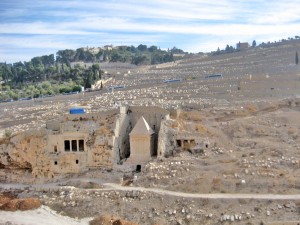
A full view of the Mount of Olives and its massive Jewish cemetery (note all of the gravestones in the foreground and elsewhere up the hill). Absalom's Tomb is the conical structure in the side of the hill.
One final view before we start the first of several steep ascents.

The Kidron Valley continues in front of us with the Arab city of Silwan to the left. We will begin the climb on the steps to the right up to the Old City.
Tomorrow, your humble servant will meet you on those steps.
Addendum: Vocabulary suggestions will resume on Friday.

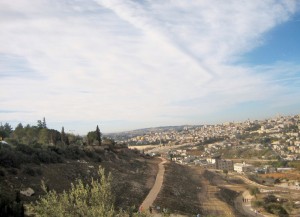
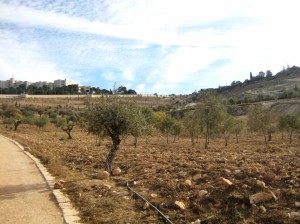

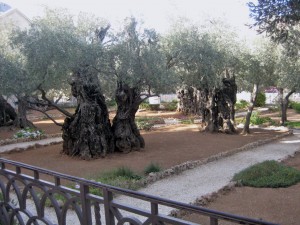


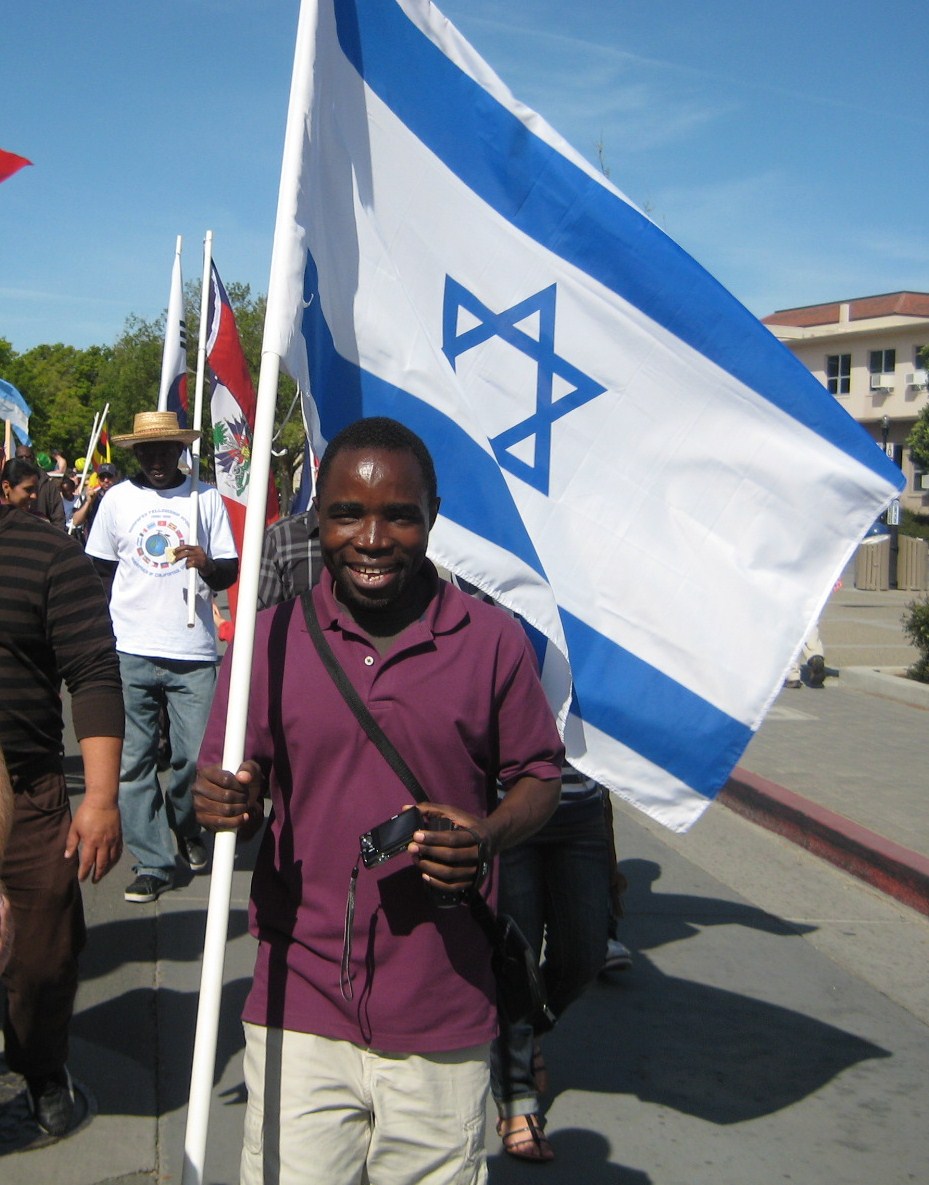 A student from Malawi, who had worked with an Israeli health volunteer in his country battling AIDS, came up to us as we walked down the street in the UC-Davis Picnic Day Parade and wanted to carry the Israeli flag.
A student from Malawi, who had worked with an Israeli health volunteer in his country battling AIDS, came up to us as we walked down the street in the UC-Davis Picnic Day Parade and wanted to carry the Israeli flag.